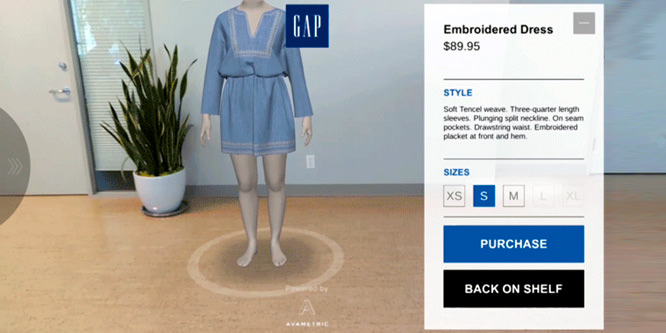
Source: Gap
February 6, 2017
Can augmented reality solve the virtual dressing room problem?
Capitalizing on advances in augmented reality (AR), Gap is piloting an app that lets consumers see how outfits might look on their bodies.
Shoppers select one of five body types and start trying on clothes.
“When seen through the app, the mannequin looks like it is standing in the same room as the shopper, blending a view of the real world with digital enhancements, à la Pokemon Go,” writes Women’s Wear Daily. “The shopper can ‘walk around’ the mannequin and add in an additional mannequin to compare two images.”
In a blog entry, Gap said the app builds on its efforts to better match the way customers are shaped instead of just looking at “fit model” sizes. Made in collaboration with Google and app-developer Avametric, the DressingRoom by Gap app focuses on how fabric stretch, drape and feel affect the sensation of fit.
Gap is the first major retailer to test a virtual dressing room app.
Hyped for about a decade, virtual dressing rooms promise to significantly improve conversion rates for apparel online, a channel that pales in comparison to the conversion rates physical stores see in their dressing rooms. Improving fit accuracy would also significantly reduce the high rate and cost of online returns for retailers.
The DressingRoom by Gap also promises to complement or advance existing online tools that let users input their height, weight and fit preference to improve sizing accuracy.
Yet the app shows the limitations of virtual dressing rooms. Instead of real-life images via virtual reality (VR), it shows a mannequin with a similar-body type using AR. Speaking to Engadget, Avametric CEO Ari Bloom said VR still faces “immediate barriers” while the success of Pokémon Go shows AR is more proven.
3D-body scanning has also been hyped as a way to achieve a more-accurate fit than in-store dressing rooms. Speaking to MarketWatch, Gil Krakowsky, VP of global strategy and business development at Gap, said body scanning would require retailers to keep the user’s measurement data. He added, “I’m not sure all customers want that.”
- Gap Tests New Virtual Dressing Room – Gap
- Gap wants your phone to help you decide if your bottom looks big in that dress – MarketWatch
- Gap’s Approach to Its Augmented Reality App: Wait and See – Women’s Wear Daily
- When Will AR Replace the Fitting Room? – Mashable
- Could 3D body scanning mean never entering another dressing room again? – Quartz
- Gap envisions a future with augmented-reality ‘dressing rooms’ – Engadget
Discussion Questions
DISCUSSION QUESTIONS: What do you think of the AR-enabled DressingRoom app by Gap? Will VR-enabled real-life images or body scanning be necessary to take the virtual dressing room experience to the next level?
Poll
BrainTrust
Lee Peterson
EVP Thought Leadership, Marketing, WD Partners
Recent Discussions







Gap’s DressingRoom app is more gimmick than function, but headed in the right direction. VR and body scanning are still in their infancy, but these technologies will inevitably improve and, as they do, so will the dressing room experience.
The concept is great, the execution is weak.
There are really good 3-D scanning tools that capture a user’s true body shape, not a 20 percent near match. Particularly with how women’s sizes work, unless a person happens to be close to the mannequin’s size/proportions, the representation will be incorrect and potentially create disappointment or resentment.
So, rather than being groundbreaking, I see this as an opportunity for competitors to do AR clothes sizing the right way and blindside Gap.
This is a step in the right direction for sure. It seems as though Gap is testing the AR waters before they commit to more serious technology expenditures. If they see a critical mass of consumers engage, they should have a roadmap that builds additional customization into the app to more truly reflect how clothes will fit individual consumers over time.
Sterling, I get your point and we’re just Monday morning quarterbacking as to what they’re doing, but if you’re right, that’s horrible UX. A brand either tests quietly on the side and iterates rapidly until they have a viable product or sits it out. Going half in is always a failure.
It does remind me of Gap’s former CEO laughing off Amazon’s logistics capability, thinking that a half-ass effort shipping from Gap stores would be competitive. Hmmm … where is Gap in comparison to Amazon now?
The VR/AR experience is in its infancy. While not there today, this technology, supported by advances in sensor technology, will certainly blow the walls off of the dressing room experience in the not-too-distant future. I suspect an accurate laser scan of our bodies will travel with us on our mobile device and clothes of interest will be photographed and digitally fit over our scans — giving us a 360-view of what would we look like in an outfit. I suspect there won’t be an actual dressing room required.
There is a big difference between the Pokemon Go experience and a woman trying on a dress. At this stage, the AR experience will not be sufficient to convert very many online sales. However, it may be much like Lowe’s at home “visualization of your room” experience … it may play a role in pre-store engagement and narrowing selection before the store visit.
In an omnichannel world it is not about where the sales transaction takes place … it is about the cumulative experiences that build engagement and trust to the levels where the consumer decides where, how and when to make a purchase.
The AR-enabled dressing room is a nice gimmick, but it’s premised on having clothes that a customer wants. And there Gap has a problem.
When an approach solves problems to the extent that fitting room augmented reality can, it must increase its contribution to customer time saving and conversion. But the augmented mirror has to be approached holistically including features such as associate calling/awareness, cross-selling and inventory visibility. The fitting room is the prime customer experience point-of-purchase location and one in which the digital experience empowers product selection. The comprehensive approach demonstrated at NRF2016 by British Telecom (see my article on this here) points the way for this high-impact innovation.
This is just the beginning. Right now it’s cool — and some may consider it a gimmick. As it is refined, it will be a great way to help customers make choices. But for that to happen, the image of the mannequin (with a choice of five body types) has to be replaced with an image of the customer. Uploading a customer’s picture which the computer can use to fit images of merchandise to the customer’s body can’t be that far away. And when that happens the virtual dressing room will take off.
Anything that can help the dismal conversion and return problem for online retailers is a plus. But no buying decision is final until the try-on has been completed, whether that’s in the fitting room or at home.
AR can increase the fidelity of the online experience but will never replace the actual try-on when the items are received. The correct fit, feel and look can only be determined when the item is tried on.
Retailers with brick-and-mortar presences should do everything in their power to get customers into their fitting rooms and provide an experience that meets their expectations. Both conversion and returns are exponentially improved when customers visit stores rather than purchase clothing online.
Gap’s approach is the latest advancement over what eyewear retailers have been doing with a digital mirror to let you virtually try on glasses after glasses.
With an app based on multiple “body types” we’re not talking about near-100% fit accuracy that can be achieved with 360 degree scanners. Having been through such a scanning process at Alton Lane and purchasing the resulting clothing, I can say the scanning approach does produce fantastic accuracy in fit and has made me a loyal customer.
We’ll see if this app garners enough adoption to move the needle — but it does assume Gap already has the product assortment customers want. It doesn’t address that issue.
Individual fit, look and feel preferences are deeply subjective without rhyme or reason. In my research and experience with building the fit and shape standards for many brands, I have found that women and men shop for clothing based on their individual emotional and sensory requirements of fit, look and feel. Personal fit is not about knowing the measurements of the individual customer or the measurements of the garment itself. I have witnessed hundreds of women trying on and purchasing clothes that defy logic. It all boils down to how a woman likes to wear her clothes. That is why body scanning and garment measurements are not able to make useful apparel product recommendations.
Clothes encapsulate the body, different brands have different shapes, ease allowances, fabrication and construction, all variables that affect how the end product “fits.” Along with words being subjective. My “loose” is your “tight,” for instance.
A woman may not be able to button “a tailored jacket, but that does not mean it doesn’t fit her personal preferences of fit, look and feel. In other words, how she likes the jacket to fit and shape her body, how she looks in the jacket in the mirror and how she “feels” (sexy, smart, professional, etc.) in the jacket.
A visual representation in a fitting room or scanning my body for measurements has nothing to do with my sensory preferences of fit, look, and feel. If sensory preferences are not met, the result is a return or a closet with the tags dangling.
How many of you have ever worn an outfit and felt like a million bucks? Great feeling, isn’t it? Pleasure, confidence … game on!
Or how many of you have gone to an important business meeting hating what you were wearing? How did that feel? Why did you feel that way?
Individual preferences of fit, look and feel being met reduce returns.
As VR and AR grow more and more popular over the years, it’s small steps of progress like this app that will propel it out of its infancy stage. Eventually, I believe people will be more open to the idea of body scanning in order to view accurate previews of clothes, but today there would be few early adopters willing to participate. When it comes to taking the virtual dressing room experience to the next level, it would take both real-life images and body scanning to accurately imitate physical dressing rooms. Nothing, however, can replace actually trying on the outfit to see how it feels and reacts, at least not yet.
Okay, this is how I can tell I’m still a digital immigrant: I just don’t get VR for retail. Using it to try something on? Really? I’d MUCH rather just order it online and send it back if it doesn’t fit. I’m an expert now at sending things back, mostly because retailers (out of necessity) have made it so easy.
Do we think that maybe if the stores were more inviting and interesting and the sales associates were awesome that we’d want to go to the store (more often) to try things on? I’m just saying: blocking and tackling vs whiz bang — works every time.
I’m dubious anything is going to work if the clothing isn’t made to pattern, i.e. if it’s sloppily made and doesn’t conform to whatever is a retailer’s version of a particular size. We all know different stores have different ideas of vague notions like “medium” or “slim” and if everything worked as planned, this process could account for that. But as we’ve all — I imagine — encountered fluctuations even in unambiguous issues like waist size, one has to think it’s also a quality control issue … and one that the technology will find difficult to deal with.
AR is a creative attempt to bridge the gap between digital and physical. There is definitely a disadvantage to buying apparel online vs. in-store. While AR is interesting and many consumers will try it, AR is probably more of a novelty than a game changer. There is no substitute for physically trying on clothes to see how they feel. This experience will never be duplicated online.
I am not convinced that body scanning of individuals is coming soon, as it has two challenges — feasibility and privacy. Getting a consumer to achieve a real-life body scan would probably have to be done in the store and then it will only be good for one brand. That is a cumbersome process for something that is only useful at one retail brand. Secondly, I doubt a lot of people will be comfortable with the retailer having access to a scan of their body. The technique is being used in vision to try on frames with the actual customer image and that is a very interesting way to interact both online and in the store. It will be interesting to see how this technology evolves for retail.
I’m afraid this will end in tears — for so many reasons. Though I applaud GAP trying, I just hope they’ve not invested too much time and money (and belief that this will succeed). Gimmicks get the PR but when they let down shoppers, the longer term effects are damaging. Beacons by example. Over promised, under delivered. Shoppers switched off. Literally. Early adopters may forgive, however the majority tend to remember.